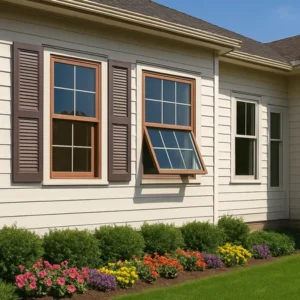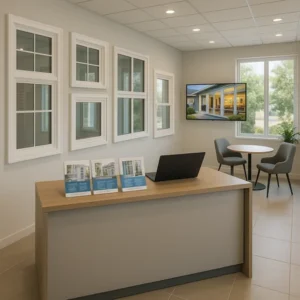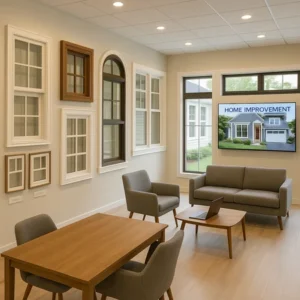Many homeowners have questions about how to compare the performance of different windows. With so much information available and manufacturers all making claims that their product is best, it is easy to be overwhelmed by all the numbers. Consumers find it difficult to make meaningful comparisons between window lines as they sort out the various ratings that are used to indicate window performance.
We recommend looking to the National Fenestration Rating Council (NRFC) and the American Architectural Manufacturers Association (AAMA) for guidance. They both provide accurate information to measure and compare energy performance of windows, doors and skylights. They administer the uniform, independent rating and labeling system for the energy performance of windows, doors, skylights, and attachment products. So what specific metrics are measured to compare window performance, and what should you know about each?
We have compiled a list of the most notable window performance metrics for your review.
U-Factor – measures how well a product prevents heat from escaping. The rate of heat loss is indicated in terms of the U-factor (U-value) of a window assembly. U-Factor ratings generally fall between 0.20 and 1.20. The insulating value is indicated by the R-value, which is the inverse of the U-value. The lower the U-value, the greater a window’s resistance to heat flow and the better its insulating value. In terms of performance, windows with lower U-Factors help to keep a home warm in the winter and cool in the summer.
Solar Heat Gain Coefficient (SHGC)- measures how well a product blocks heat caused by sunlight. The SHGC is the fraction of incident solar radiation admitted through a window, either directly or absorbed and subsequently released inward. SHGC is expressed as a number between 0 and 1. The lower a window’s solar heat gain coefficient, the less solar heat it transmits.
In a desert climate, consumers require a low SHGC so that the brutal afternoon sun will not overheat the home. In cooler climates such as the Mid-Atlantic or Northeast, consumers spend more energy dollars heating their home than cooling it. Therefore, they often choose a window with a more moderate or higher SHGC that will allow the sun’s rays to warm their home during winter months.
Visible Transmittance (VT) – measures how much light comes through a product. The visible transmittance is an optical property that indicates the amount of visible light transmitted. VT is expressed as a number between 0 and 1. The higher the VT, the more light is transmitted.
A typical piece of clear, annealed glass has a VT of .93, meaning 93% of the light that hits the glass passes through. Add a second lite, and the VT goes down to about 88%. These are general figures because different types of glass can vary. When tints are added to the glass, or coatings such as Low-E are applied, the VT can also be affected.
Air Leakage (AL) – is indicated by an air leakage rating expressed as the equivalent cubic feet of air passing through a square foot of window area (cfm/sq ft). Heat loss and gain occur by infiltration through cracks in the window assembly. The lower the AL, the less air will pass through these cracks.
Condensation Resistance (CR) – measures the ability of a product to resist the formation of condensation on the interior surface of that product. The higher the CR rating, the better that product is at resisting condensation formation. While this rating cannot predict condensation, it can provide a credible method of comparing the potential of various products for condensation formation. CR is expressed as a number between 0 and 100. This is an optional field on the NRFC rating sticker and many manufacturers do not include it.
Design Pressure (DP) or Performance Grade – is based on laboratory pressure testing in pounds per square foot or psf. Design pressure requirements can vary as they are based on product location on the building, height of the building, density of buildings, and wind zone designation. The positive DP number is the standard for wind blowing at the building (windward) and the negative DP number represents the vacuum pressure on the opposite side of the building (leeward). This value is particularly important for homes in a hurricane zone, and building codes strictly enforce minimum requirements.
Structural Test Pressure = 1.5 x Design Pressure
Structural is tested at 150% of DP rating. The structural rating of a window is as much about the glass as it is about the frame and sash system. In order to get a higher DP rating the window manufacturer has to consider the thickness and possible heat-strengthening (or tempering) of the glass as well as the use of higher-end hardware and good quality sealants in the frame and sash system.
Sound Transmission Class (STC) – ratings are an established way to average how much sound is stopped by traveling through a material. STC ratings are used for windows, doors, walls and most building materials. For windows, STC ratings range from 18 to 50. The STC Ratings for double paned windows generally vary from 28 to 35. Take air seals out of the equation, and most of the variation is due to the glass thickness and the amount of air space between the glass. The bigger air space and thicker glass is preferred, as the result is better sound proofing.
At Windows on Washington, we give our customers the facts they need to make an informed decision. We take a consultative, no-pressure approach to answering all your questions and create a work scope that meets your home improvement needs. By providing our customers with quality products, expert workmanship and a lifetime warranty, we make homes more beautiful, comfortable and energy efficient. Windows on Washington is home improvement you can trust.



